Get PeakVisor App
Sign In
Search by GPS coordinates
- Latitude
- ° ' ''
- Longitude
- ° ' ''
- Units of Length

Yes
Cancel
Share ×

Scan the QR code and open PeakVisor on your phone
❤ Wishlist ×
Choose
Delete
There are places you dream of, places you imagine, places that motivate you and places that catch you by surprise. The Garajonay National Park in La Gomera falls into this latter category. The permanent presence of mists coming from the Atlantic trade winds that unload their general moisture on the insular summits gives the region unimaginable freshness and humidity. Such a unique climatic arrangement has facilitated the development of jungles that existed in the Mediterranean basin millions of years before, the laurel forest being the most exemplary representative of this lush vegetation.
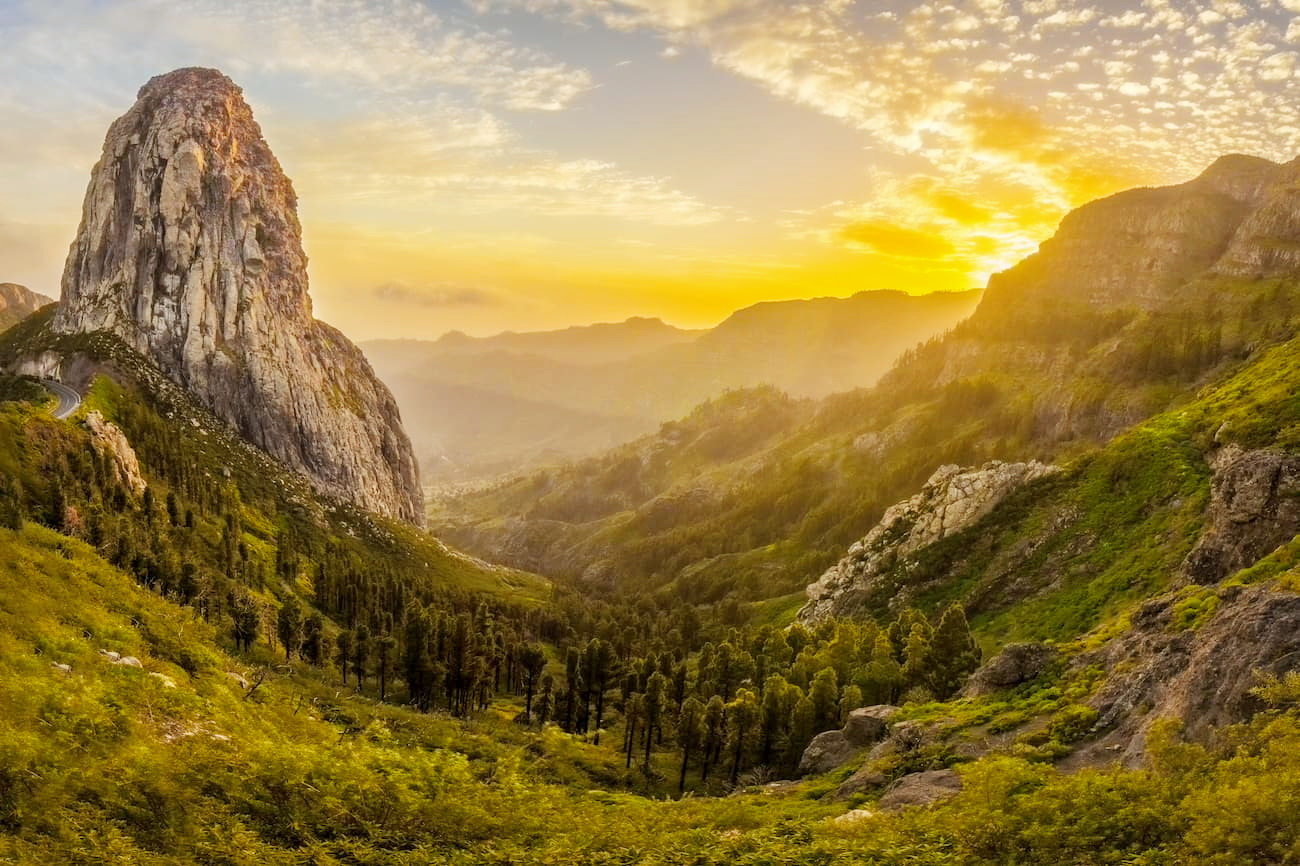
According to a legend, prior to the conquest of the Canary Islands by the Spanish, the word 'Garajonay' came from the names of the young Gomera princess Gara and the young Tenerife prince Jonay. This love story, which dates back hundreds if not thousands of years, bears a curious resemblance to the work of the immortal British writer William Shakespeare 'Romeo and Juliet' and is set in what is now the Garajonay National Park.
The legend says that Gara and Jonay met and fell in love after an oracle warned Gara not to approach the fire. When Tenerife's Teide volcano erupted, families separated the lovers fearing the prophecy. But Gara and Jonay met in La Gomera, ran away to the summits and there, seeing themselves cornered by their families, they decided to make their love eternal by embracing each other while piercing their hearts with a cedar wood stick.
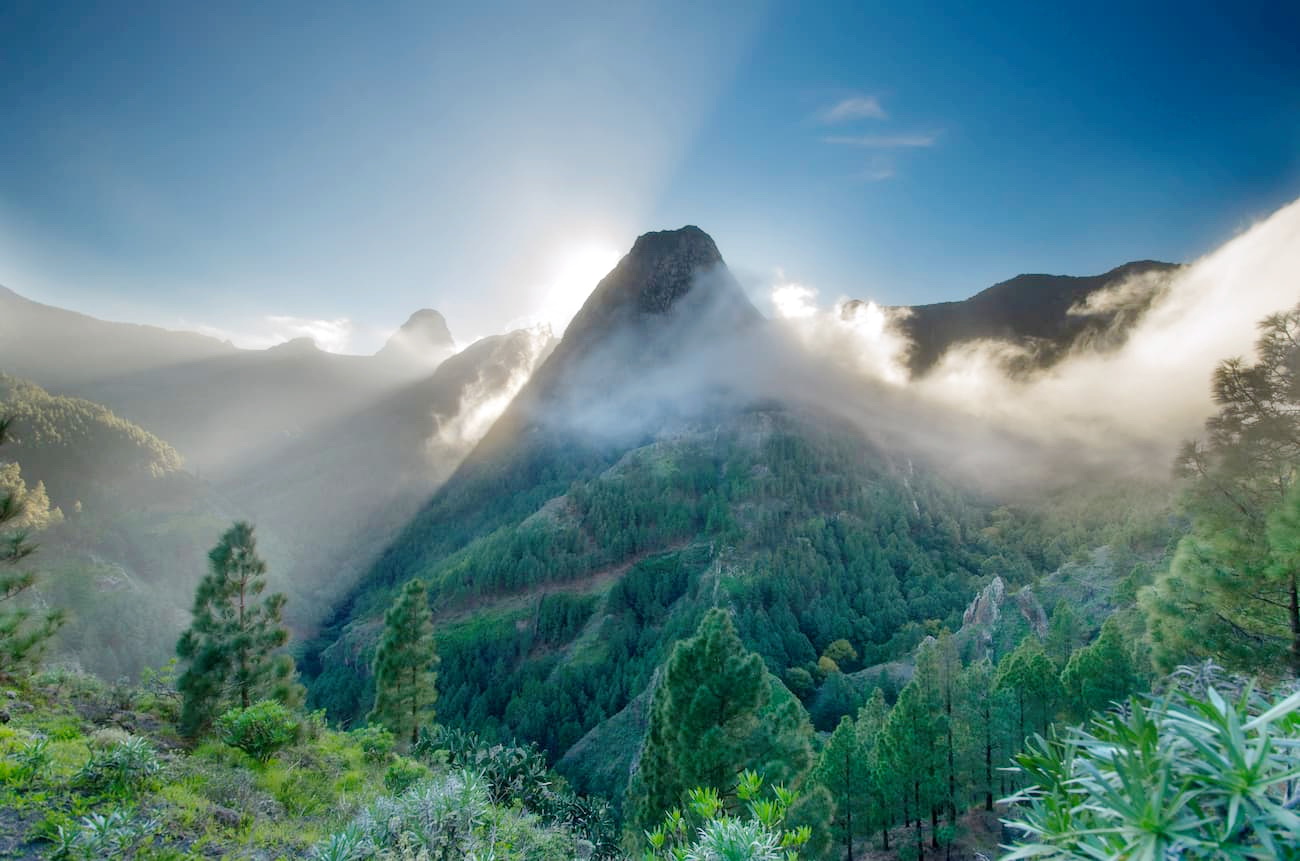
A few centuries ago, the aborigines of La Gomera came to the Garajonay to get some firewood and food, but did not live there. Probably due to the high degree of humidity always present in the area, they preferred to live down the slopes, closer to the sea. However, in the summer, they did bring their animals to graze in the area and even built cabins to protect themselves. Later, the need for raw materials put La Gomera on the map of international navigation with the landing of Christopher Columbus, which meant that forests were exploited to obtain wood. Grazing also intensified.
From the 15th to the 19th century, the Lords of La Gomera held land ownership and imposed a very restrictive use of this forest mass. From the 19th century onwards, feudal jurisdictions were abolished and the property of Garajonay was transferred to the municipalities. It was not until the 40s-50s of the last century when the grazing and harvesting of wood reduced.
The measures taken in the 1970s lead to the creation of the Garajonay National Park in 1981. Thanks to this conservationist policy we can now enjoy the best preserved forests in Spain. In 1986, it became part of the UNESCO World Heritage, the highest recognition that a protected natural space can achieve. It currently receives almost a million visitors and is the third most visited park in the Canary Islands, after El Teide National Park (Tenerife) and Timanfaya National Park (Lanzarote).
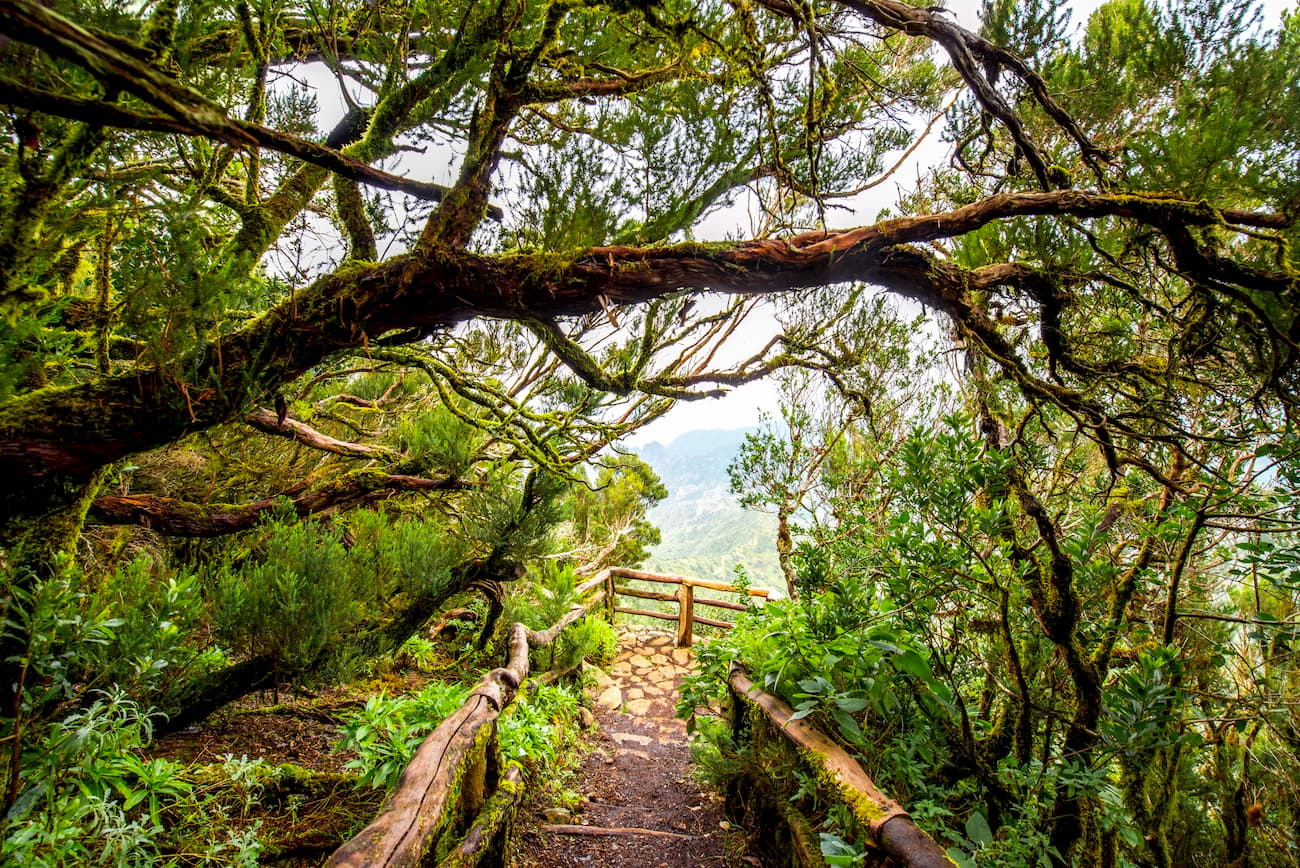
The park stands out above all for being the main preservation ground for the Canarian laurel forest, an ecosystem from the Tertiary Era. This type of vegetation disappeared from the continent as a result of climatic changes that occurred in the Quaternary. The laurel forest of Garajonay concentrates half of the mature arboreal population of this type throughout the archipelago, under optimal conservation conditions. This Canarian laurel forest occupies an area of about 4,000 hectares, representing about 11 percent of the island's total area. It’s a relic of the subtropical forests that occupied a large part of Europe and North Africa several million years ago, which is why Garajonay can be considered a true living fossil. Also notable is the abundance of mosses and lichens that cover the trunks of the trees, as well as plenty of ferns, the true indicators of high environmental humidity.
The Garajonay forests are not homogeneous, there are different types of forests and other plant formations all in all over 2000 species of flora. There is a high number of endemic species exclusive to La Gomera Island and the other Canary Islands as well. The park can also boast of the streams that make up the network of permanent water currents best preserved in the Canary Islands.

The great variety of habitats in the Park is home to a rich and diverse fauna made up of invertebrates, vertebrates, amphibians, reptiles and birds, many of them endemic. Within this latter group it’s worth mentioning the rabiche pigeon and the turquoise pigeon.
The Park has a wide network of various tourist facilities and services among which are the Visitor Center, the Information Center, a wide network of viewpoints, recreational areas, as well as a network of perfectly signposted trails that allow you gain better knowledge of the area and let you enjoy this authentic natural gem.
The Garajonay National Park has a permanent environmental educational programme for the local population but actually, any group, school or association can request, in advance, a guided visit, or specialized talks or other types of activities related to the Park and nature.

Managed by the Insular Council of La Gomera, there is a Nature Classroom in the Caserío de El Cedro, in the vicinity of the Park, it is designed to house groups for environmental educational activities.
Close to the aforementioned classroom, the Park has an Environmental Workshop, which is an installation equipped with an exhibition, nurseries and orchards, which make it an ideal place to carry out group projects.
ALTO DE GARAJONAY
Alto de Garajonay (1,487m) is the highest point on the island. It towers over the island and offers a staggering panorama of the whole La Gomera on clear days. You can also see the islands of La Palma, El Hierro, Tenerife and even Gran Canaria if the day is very clear. Perhaps due to its strategic location, this place is surrounded by mysteries and legends. Before the invasion of the Castilian, the ancient inhabitants of the island had their own beliefs and the place used to be considered benevolent for worship, rites and sacrifices.
According to researchers, the ancient people created a calendar that allowed them, with the help of the sun, to determine the times of cultivation and harvest. It’s also assumed to be a great sanctuary for being closer to heaven than other places on the island and pretty far away from human settlements.

During the European invasion, the fleeing inhabitants of La Gomera arrived at this site as the last refuge point.
During 2012, a series of fires raging in the area severely affected the park and caused detrimental damage to its vegetation, the after-effects of which are felt even today. The only good thing about the fire was that it allowed researchers to find new archaeological sites that might shed more light on the life of the Gomeran ancestors.
The El Cedro forest furrowed by the relaxing stream of El Cedro is undoubtedly the star of the Garajonay National Park and one of the reasons for being appointed as Unesco World Heritage Site in 1986. It’s a small sector of the great laurel forest that occupies 85% of the national park. However, El Cedro is unique, as it’s an old forest that remained unchanged for centuries. It is shrouded in mystery, has many legends and stories attached to it.
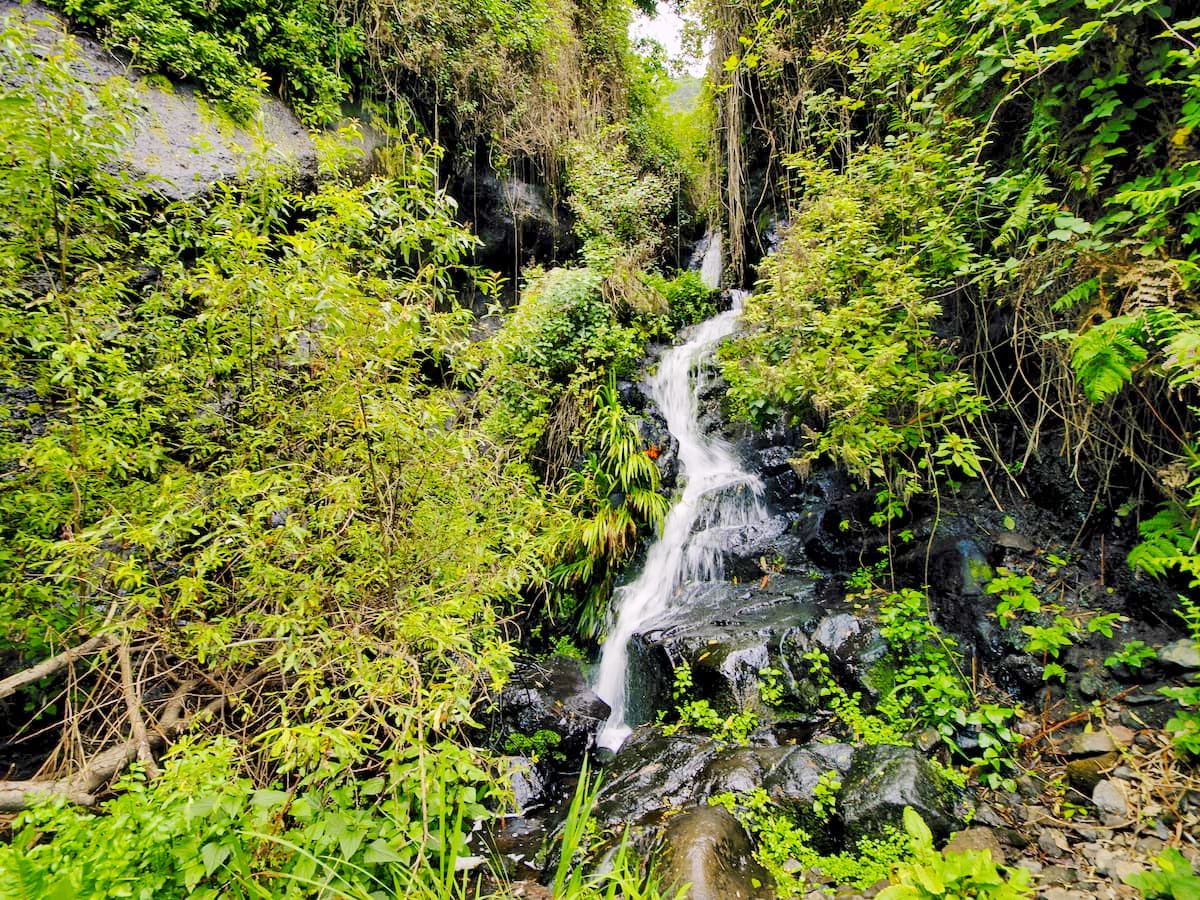
The laurel forest features a large number of mixed trees (El Cedro has about 12 species), all of them with leaves similar to that of the laurel. Inside, the created microclimate allows for an incredible biodiversity with great natural synergies and symbioses and full of endemisms. Mosses and lichens grow on the branches of the trees, and the ground is covered with multicolored leaves and ferns that give the place a prehistoric and mysterious feel.
A continuous flow of water accompanies whoever enters this area of the park. Few places in the Canary Islands have a stream with permanent waters and El Cedro is possibly the best example of this. Every drop of water here is loaded with history. It originates high in the clouds which are swept by the trade winds to meet the slopes of the north face of the island. When those fluffy white beasts finally collide with the trees that act as sponges, the water droplets fill the air making a very fine mist, almost omnipresent in the park. This incredible phenomenon is known as horizontal rain and is responsible for feeding the channel of this stream with every drop that comes from so far. Knowing its history, we can appreciate even more the visual and sensitive beauty of the water following its passage.
The crisp pure air, the songs of the birds and the flow of the water invite you to stop, open up all your senses and try to catch all the magic that the place generously provides.
Laguna Grande is the largest recreational area in the Garajonay National Park and an ideal place to spend a day with the family. This open esplanade of vegetation is surrounded by thick laurel forests and located near the top of Garajonay and only 35 minutes by car from the island's capital, San Sebastián de La Gomera.

The area has an information point with an official guide, a playground, toilets, parking lots and a picnic area with tables, benches and a stove. A circular path of 900 meters in length and low difficulty runs through the surrounding forests. This comfortable and short circular route is recommended for all types of visitors and it’s one of the trails with the highest number of visitors due to its location. On this short route, you can visit a type of forest called fayal-brezal, characteristic of the driest southern slope of the Park.
In late April and early May, beautiful tapestries of flowers brighten the journey. It has a viewpoint to enjoy the Cherelepi Fortress, a volcanic dome covered in vegetation. This route is equipped with interpretive panels that explain some of the gems found on the route.
In the Laguna Grande restaurant, next to the area, you can savor roasted meat and dishes made with palm honey, a delicious syrup of the Canarian palm tree sap.

The Garajonay National Park guards a treasure of biodiversity, history, traditions and legends under the thickness of its foliage. All this wealth is illustrated by the information panels, audiovisual projections and exhibits of the Visitor Center. It’s located in a place known as Juego de Bolas (Ball Game), in La Palmita, Agulo, in the north of La Gomera and 3 km from the Park. It’s advisable to visit the Center before starting the trip, as it provides information about all the facilities of the Park. It has three exhibition rooms where the visitors can find detailed information on the Garajonay National Park and the island, books are also available. Additionally, there is an audiovisual presentation about the Park and the island.
The services offered by this Center are free, including the reservation of places on the interpretive routes with official park guides and the pamphlets that accompany the self-guided routes. Garajonay's intimate relationship with the island's inhabitants is perfectly reflected in the ethnographic museum and the craft workshop located inside the Center. The visitor can acquire elaborate artisan pieces that would be sweet reminders of the terrific time spent in La Gomera.
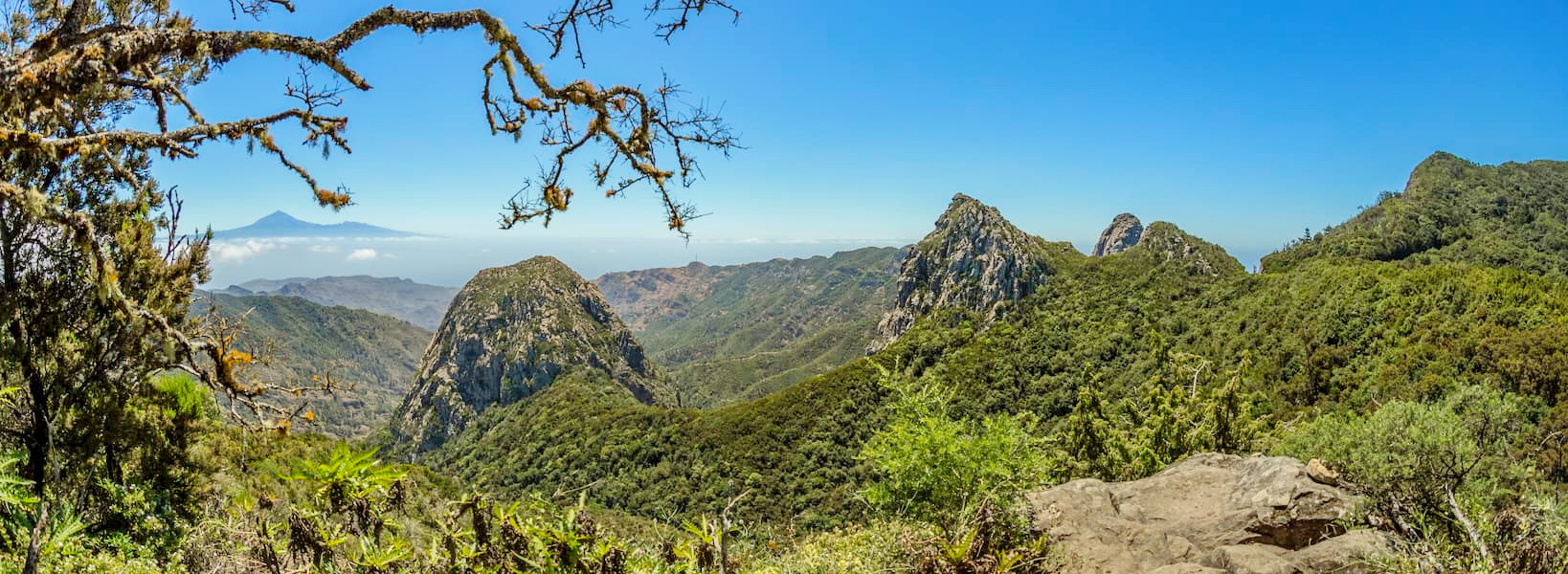
Outside, the visitors can enjoy the gardens where the flora of the Canary Islands including many plants endemic to La Gomera is widely represented. Those gardens also exhibit plants used by the locals in popular medicine and in gastronomy as seasonings.
The House of Memory exhibits many different samples of traditional culture: the inside of a rural house, farm equipment, a cellar, traditional pottery and much more. There is also an audiovisual presentation of different samples of traditional culture: handcraft, terraces building, extraction of Palm honey etc.
The Center has craft shops where the visitor can buy handicraft products such as pottery, "ristra" (crafts made with dried leaves of banana trees), weavings of different types including basket weaving. There is also a small coffee shop where you can taste delicious local sweets.
Opening times: Monday to Sunday from 9:30 to 16:30 Phone: (922) 80 09 93.
The Park has a wide range of viewpoints around the road network which offer lovely panoramic views. There are also explanatory panels to be found there so that you know what you are looking at and the natural treasures that are to be seen there.
There are infoboards and QR codes to download to your mobile phone to learn more about the landscape and the recreational area you are enjoying.
These viewpoints are:
Located at the highest point on the Island, it offers views of the Park and a large part of the island and of other nearby islands. What is more, there are archaeological sites here which have been primed for visiting.

Located at the top of the Rejo Ravine, it allows you to observe the ravine from its topmost point in the highlands, with the view continuing down to the bottom of the Hermigua ravine and the coast. Likewise, the immediate environment is an excellent place for observation of the abundant plant life which colonises the numerous rock walls found in the vicinity.
Located at the crest of the island, they show an excellent panorama of the Conjunto de los Roques towards the south and a view of the head of the Hermigua Ravine towards the north. This is an excellent place to see pigeons passing by.
It’s a set of viewpoints that offer stunning views of the Los Roques Natural Monument. Los Roques are huge blocks of stone formed by magma that never came to the surface and gradually came into view due to erosion. They are the Rock of Agando (the largest), Las Lajas, Carmona and Ojila.
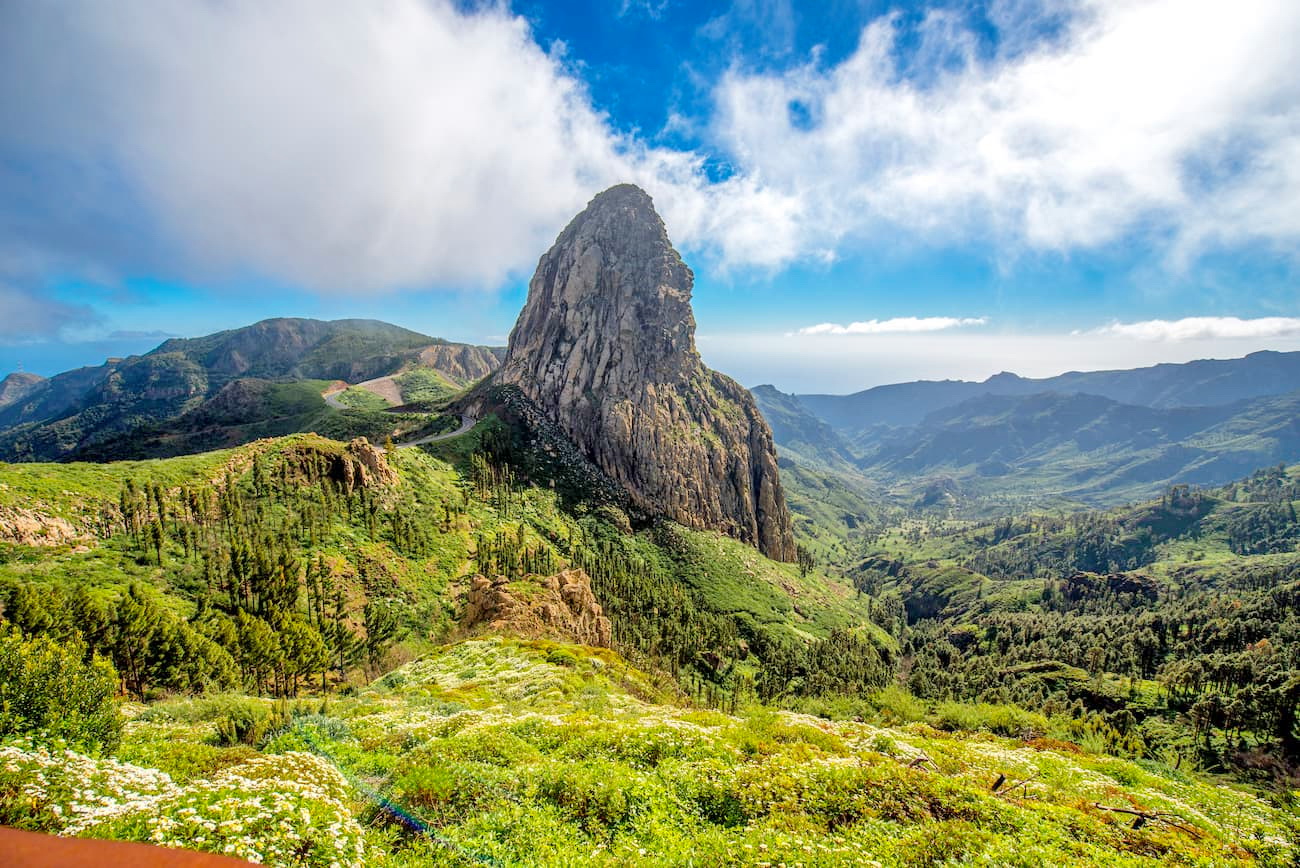
The most spectacular viewpoint and one of the busiest in La Gomera is the Mirador del Roque de Agando. The ravines of La Laja and Benchijigua start from here, they are probably the most beautiful valleys on the island. You can also see the cultivated terraces on the slopes of the ravines, sometimes with an almost impossible inclination. For the aborigines the Roque was a magical place and on its top they left carved stones and fragments of animal bones that can indicate the performance of ritual sacrifices.
Located in the highlands of the island, at the very edge of the Park, this viewing point overlooks the erosive caldera of Benchijigua to the south, with its arid landscape standing in contrast to the leafiness and luxuriance of the El Cedro ravine, which is oriented towards the north and covered in laurel woodland.
Located at the southern end of the Park, at the edge of the central plateau of the island, it offers a superb view of the Chipude Fortress and of the erosive Caldera of Erques. The viewing point has a monument devoted to the Gomeran whistling language.

It offers a panoramic view of the northern slopes of the island in the borough of Vallehermoso where the most extensive juniper woods of the Canaries are to be found.

It offers a panoramic view of the valleys and hills of the northern slopes of the Park, covered in laurel woodland.
A view of the east coast of the island with La Palma and El Hierro on the horizon, as well as the cliffs which run around the central plateau of the island where the National Park is located.

The Garajonay National Park is made up of a network of 18 approved routes of different levels and durations. The roads are well marked and some are self-guided, that is, they have pointers where you can scan a QR code with your mobile and listen to very interesting details of what you see. Most of the routes are very easy and some are of a very short duration, many of them overlap so you can do several on the same day.
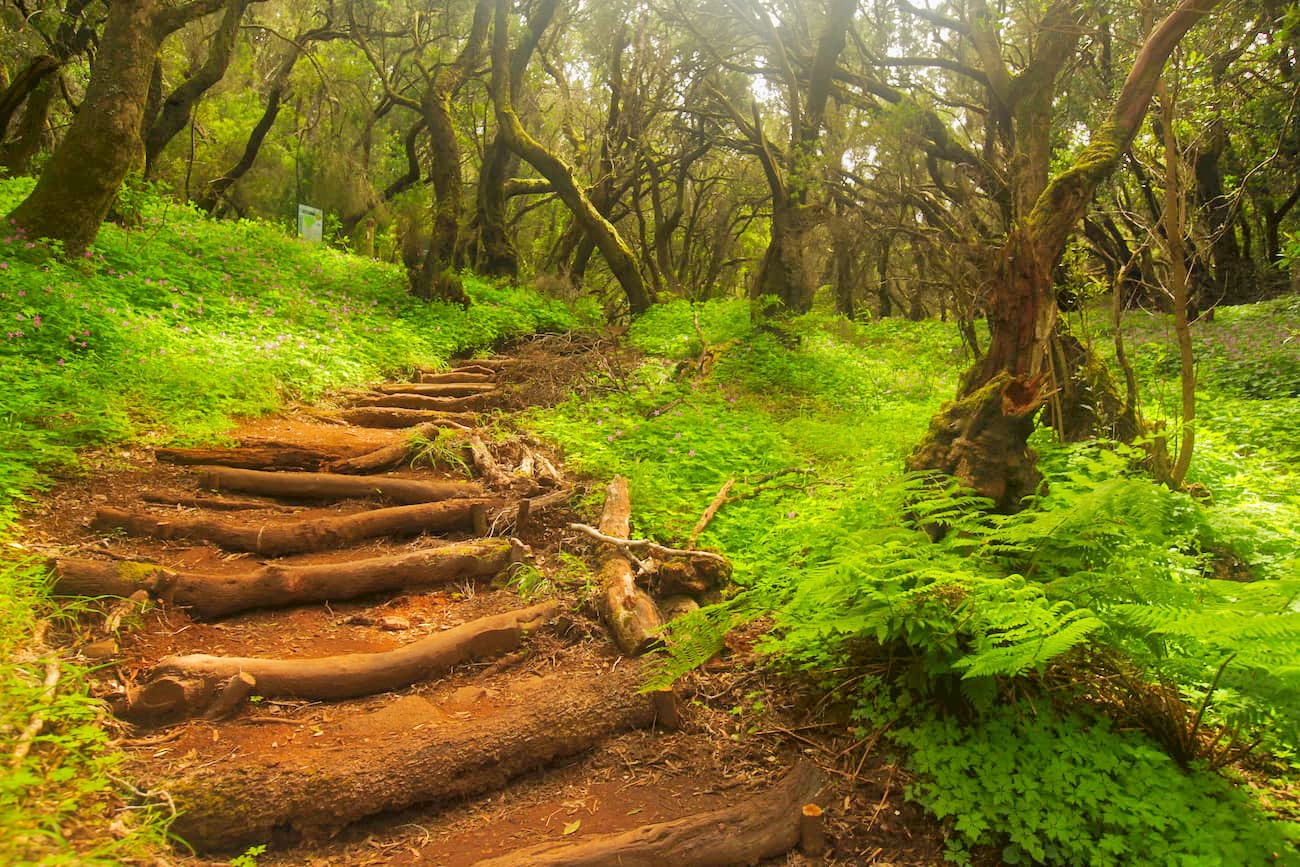
The main trails of the network are:
If you have taken a look at all the routes within the park you will see that there are many and some of longer duration. For the most motivated and with enough time on the island, I would recommend doing the Garajonay circular route. It’s perfect for discovering the best landscapes in the park in just one day. Of course, it’s a hard one because you will have to cover 16 kilometers in 7-9 hours (depending on your pace) with a large elevation gain and drop. There are some sections that coincide with other smaller routes.
The National Park offers a chance to get to know the environment you are blessed to be in through the guided tours in which the Park guides explain the natural values of the routes to the visitors. The guided tours, which are free, take place every Friday. During the summer, you can also book one of these tours on Wednesdays. Guided tours must be booked in advance.
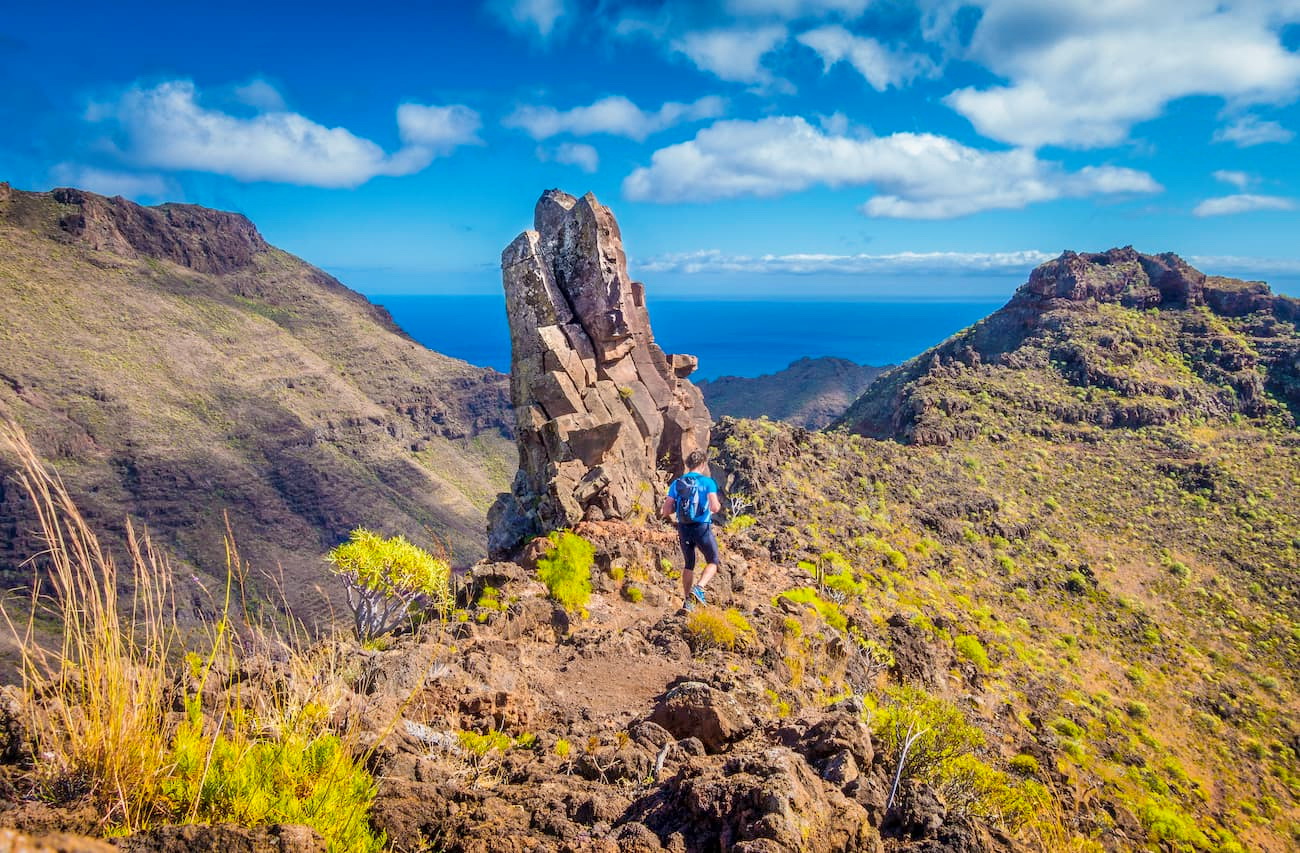
By car: Due to its central location, you can access the park from any town on the island.
Line 1: Valle Gran Rey - San Sebastián
Line 2: Vallehermoso - San Sebastián
Line 3: Alajeró - San Sebastián

Los Patos rural home: Caserío del Cedro, s/n, Hermigua. La Gomera. (+34) 922 100 836
Casa Cesarina 2: Hermigua, La Gomera. (check website for details)
Explore Garajonay National Park with the PeakVisor 3D Map and identify its summits.








